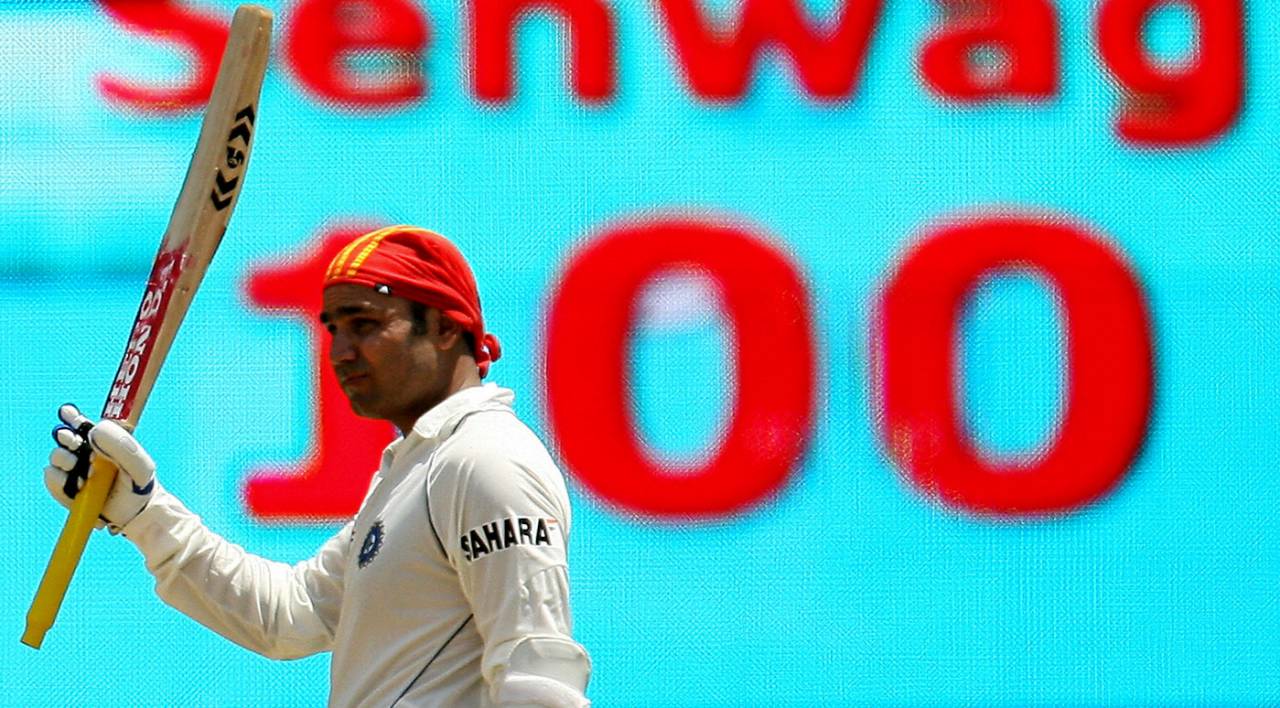And so the great
Sehwag rides off into the sunset, his international career concluding as it began: on his own terms. Avatar, revolutionary, seer, he has ushered in batting's new age, and, like Muhammad Ali, has been able to conceptualise his work. "See ball, hit ball" is cricket's "Float like a butterfly…", a perfect iteration of intent.
His full impact may only be apparent when the generation that grew up watching him arrives, because Sehwag, of all batsmen, was least about the raw facts and figures. Batting is a wider discipline now than ever before. As they blaze through the game's shifting sands, Sehwag and
Chris Gayle,
AB de Villiers and
Brendon McCullum,
Virat Kohli and the rest must, in their own quest for greatness, master a broader range than any of the greats that have come before: from 20 overs to five days; from 120 deliveries to two innings.
What are the figures that recognise excellence across that spread? Average? Scoring rate? Amount of runs?
Another mark of significance suggests itself. One man has achieved it. Another - the great Sehwag himself - has a version of it. And there are others two-thirds of the way towards it. It's an achievement that demands all of the skills of the contemporary player - and will continue to do so. And it is not the sort of thing that anyone can fluke their way to.
It's this: possession of a Test match triple-century, an ODI double-hundred and a T20I ton.
Grace, Len Hutton, Jack Hobbs, Viv Richards, Mark Ramprakash and more made 100 first-class centuries. Are Tendulkar's combined 100 international centuries worth more or less than those?
Gayle has all three. Sehwag does not have the T20I century but he has that
58-ball 122 in the IPL qualifier of 2014 for Kings XI against Chennai Super Kings, an innings played on an occasion of note, against an attack that featured four international bowlers: Ashish Nehra, Mohit Sharma, R Ashwin and Ravi Jadeja.
Brendon McCullum has the
Test triple and the
T20I hundred. His compatriot Martin Guptill has both of the white-ball innings. So does Rohit Sharma. Hashim Amla and Younis Khan have the Test triple but neither of the white-ball scores. Mahela Jayawardene retired with the Test and T20I in the bag.
An indication of the difficulty of achieving any of this is that the man who is almost certainly the best all-round player on earth,
AB de Villiers - maker just the other day, of a
61-ball 119 - has a Test highest score of
278 not out, an ODI best of
162 not out and a T20I mark of
79 not out, which suggests, if nothing else, that he doesn't go in early enough. And Kohli, Joe Root, Kane Williamson? All in the same boat as AB…
Average has been relied upon as a marker of greatness in a couple of ways. One is to show consistency, of course, and another that it can be judged alongside that of the other great players. Yet it has always shifted due to external influence. Grace averaged 39.95 in first-class cricket, Bradman 99.94 in Tests, Chris Gayle 44.21 in T20 cricket - they all mean something, but not the same thing, and they are not directly comparable. Root's Test average is currently the
12th best of all time. Where does that place him in the pantheon?
All stats are compromised or at least mediated in one way or another. No player who retired before 1971 ever stepped on an international field to play a limited-overs game. Sachin Tendulkar spent 463 days of his life doing just that. Grace, Len Hutton, Jack Hobbs, Viv Richards, Mark Ramprakash and more made 100 first-class centuries. Are Tendulkar's combined 100 international centuries worth more or less than those?
We're constantly weighing and measuring stats to try and answer our unanswerable questions. The numbers are empirical, yet their meaning necessarily shifts.
The notion that three individual innings across the course of a career may come to carry some historical freight may be an odd one, but innings on that scale rarely stand in isolation. Instead, they are the best expression of a talent fully realised, the culmination of years of application to the art of batsmanship. There have only been
28 triple-centuries in the history of the game, just
six ODI doubles and a total of
15 T20I hundreds. These are rare things.
Gayle and Sehwag may not be regarded as classicists, but they appear multiple times on those lists because they have scored so quickly. Each has two Test triples, the same as Bradman. It's interesting to look at the number of dashers in the ranks of triple-century scorers: a high percentage of those to have scaled the peak have done so because of the rate at which they scored as much as the ability to simply remain at the crease. Speed of scoring is high on the list of qualities for the batters of the future, which will lend weight to the deeds of Gayle and Sehwag.
The 3-2-1 (as I'm calling it) won't suit everyone, but it demonstrates mastery of form. As Sehwag leaves us, it might be a fitting tribute to the revolution that he urged into existence.

